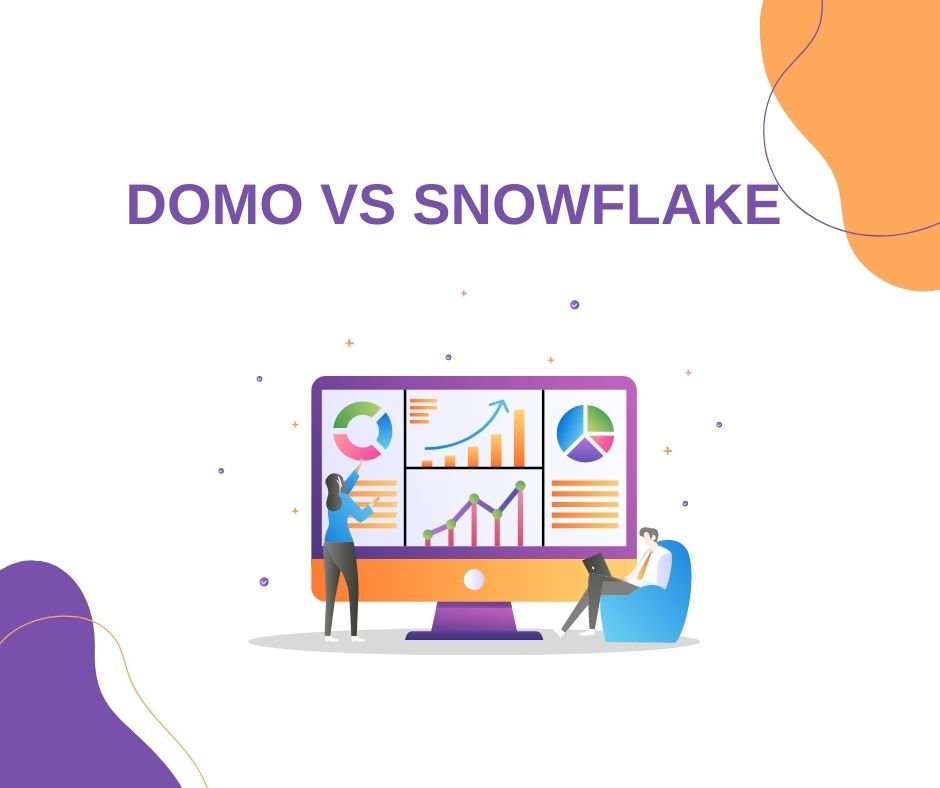Curious about what is the difference between DOMO vs Snowflake? 5 Comparisons data source integrations, pricing, features, benefits, and cons. In this article, we are going to talk in detail about these two and help you understand what both have to offer. So let us get to it.
Here is the article to explain, 5 Comparisons in the difference between DOMO vs Snowflake Reviews!
The following differences or comparisons below are;
What is DOMO?
DOMO is a business intelligence tool that has been specially designed for all small, medium and large businesses. It offers a user-friendly interface and a very impressive number of integrations. Similarly, with DOMO users can blend and transform data. It is without any doubt an extremely powerful platform but one con of using this tool is that it is very expensive. But rest assured it is a very useful tool.
What is Snowflake?
Snowflake on the other hand is a data warehousing platform that has been specially designed for all the data architects out there. This is a type of platform that is built for data architects and data engineers. With Snowflake, you can store data in the cloud for easy consumption. With that, it offers SQL workbench and with user permissions, multiple users can query data. Snowflake is a very efficient platform for handling different data types. But if you want to make the most out of Snowflake then a heavy data background is a must.
Comparison based on data source integrations:
The following data source integrations below are;
DOMO:
With DOMO you get 1000 integration to and from data stored in cloud-based platforms, proprietary systems, on-premise, and flat files. There are connectors available that mean to be plug and play. Online DOMO classes are very helpful in getting more details about its valuable features.
Snowflake:
As far as Snowflake integration is concerned, then it doesn’t offer any built-in integration instead it relies entirely on third-party tools to ingest data.
Comparison based on pricing:
The following pricing below are;
DOMO:
DOMO offers the following packages.
- Standard package starts at $83 per month per user.
- Whereas professional package starts at $160 per month per user.
For further details, you can visit their official website. All the potential users can easily connect with their sales department for pricing specifics.
Snowflake:
If we talk about Snowflake pricing then it is a little tricky as it is based on data consumption per second. So this means that you only have to pay for the computer and storage that you use. In our opinion, this pricing structure is quite convenient for experienced users who have a clear picture of their average data consumption. But new users may find this pricing structure a little inconvenient.
Comparison based on features:
The following features below are;
DOMO:
DOMO offers the following features.
- It offers data integration where you can integrate and transform your data dynamically for whatever the source you like.
- Then it offers BI and analytics which will give you an opportunity to drive action. This will be done using Domo’s real-time and predictive analytics.
- Similarly, it lets you create your own apps for the purpose of automating and activating workflows.
Snowflake:
Now let us take a look at the features of Snowflake.
- It offers a cloud agnostic solution.
- It offers concurrency and workload separation as well.
- Similarly, it offers scalability. And near-zero administration.
- Moreover, it offers great security and semi-structured data.
Comparison based on benefits or advantages or pros:
The following benefits or advantages or pros below are;
DOMO:
If you use DOMO then you can enjoy the following benefits.
- It is a very good platform for meeting multiple needs of a user.
- It offers multiple options for drag and drop ETL, redshift, and MySQL.
- Similarly, it offers a wide range of data connection. This includes more than 600 data connectors, ODBC connectors, and Excel Add-IN.
Snowflake:
Snowflake also offers a wide range of benefits to its users.
- It offers great performance and speed. This means that if you wish to load data faster or feel the need to run high volume of queries then Snowflake is the best option here.
- Similarly it offers great storage and support for all the structured and semi-structured data. You can combine them for data analysis and then load it into the cloud database without even have to convert it back.
- Snowflake offers a traditional data warehouse and along with that it offers a very large number of users.
- Lastly, it offers seamless data sharing; this means that Snowflake’s architecture lets data sharing among Snowflake users very smoothly.
Comparison based on cons or disadvatages or drawbaks:
The following cons or disadvantages or drawbaks below are;
DOMO:
With so many pros there are some cons of using DOMO which mention below.
- It offers inconsistent connectors.
- It has a slow processing time.
- With that, its customer service is not that appealing.
Snowflake:
Snowflake also has some cons which mention below.
- It can become disruptive sometimes.
- Also, It lacks synergy.
- It is very expensive.
Conclusion:
DOMO vs Snowflake both are highly competitive BI tools that can use by any individual or organization. So it is entirely up to the need of the specific person or organization. We hope this detailed comparison would have given our readers a clear image of what DOMO and Snowflake are and what they have to offer.


Leave a Reply